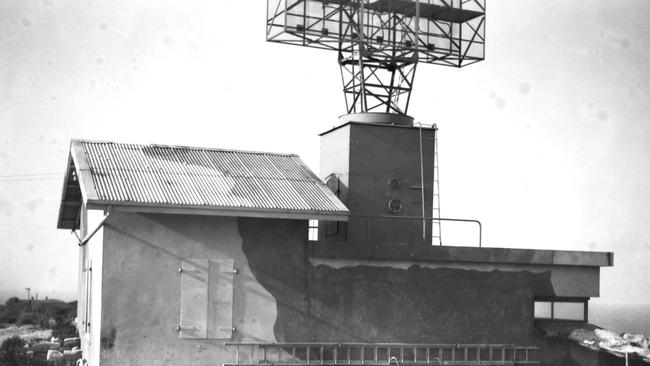A graffiti-covered concrete block on North Head has a remarkable past – as the oldest radar unit left
PERCHED on the edge of the cliff at North Head stands a wartime relic of special significance – the oldest remaining radar installation in the country.

- The master mariner who was a leading light behind the leading line
- The day timber choked the harbour beaches at Manly
- Titan was the largest floating crane in the southern hemisphere
PERCHED on the edge of the cliff at North Head stands a wartime relic of special significance – the oldest remaining radar installation in the country.
These days the concrete structure is covered in graffiti or aerosol art, depending on your point of view, but in the early 1940s it hosted one of Australia’s first forays into the new world of radar.
And with the world at war and the fear that Australia might be invaded, its historical significance can’t be underestimated.

In 1939 the British Government invited the Australian Government, along with the governments of several other nations, to send a highly-qualified scientist to learn about a breakthrough the British had developed – radar.
The Australian physicist chosen was Dr David Martyn and upon his return with information and equipment to help develop the technology in Australia, at the Federal Government’s request the Council for Scientific and Industrial Research (later called the CSIRO) established the Radiophysics Laboratory in the grounds of Sydney University and some of Australia’s best and brightest physicists joined the team.


In the first years of the war, before Japan bombed Pearl Harbor, the defence authorities in Australia believed the nation was more likely to be subjected to attacks on coastal cities and defences by ships or submarines and less likely to be subjected to aerial bombardment.
For that reason, priority was given to developing radar that would warn coastal defences of the approach of ships and, by accurate range-finding, assist in gun-laying.
At the time, optical rangefinders were in short supply and were of little use in fog or at night, whereas radar was could penetrate both.
The first radars developed were therefore coast-watching radars, or Shore Defence as they came to be called, abbreviated to ShD.

Although the ShD radar developed in Australia contained features of the British equipment, Australian physicists took it further.
Whereas the British ShD radar units relied on two separate towers – one transmitting the radio waves and one receiving them – Australian physicists developed a system whereby one tower with one aerial was used to both transmit and receive the radio waves that bounced back at it.
The ShD equipment operated on a wavelength of 1.5m (a frequency of 200 megacycles) and was thought to be good for a distance of 30 to 40km from the shore.
But the ShD units, properly called Radar Coast Artillery, No 1, Mark 2 (Aust), were large and almost impossible to hide, which was why the physicists kept trying to improve them and reduce their size.

Military historian and former serviceman Richard Fullford described the first ShD units as “large, conspicuous arrays, necessitating heavy frames and powerful rotating gear, difficult, almost impossible to conceal”.
The first Coast Artillery, No 1, Mark 2 ShD was installed at Dover Heights and during its first trials in May 1940, it was able to detect a ship off Port Stephens, 145km north of Sydney.
The second Coast Artillery, No 1, Mark 2 ShD was installed at Blue Fish Point at North Head and in February 1941 an “all-radar” shoot was conducted with the nearby 9.2-inch guns at North Head.

No suitable ship was available as a target, so an improvised wooden vessel fitted with a transmitting set to give the equivalent of a radio echo was towed out to sea. The trial was successful.
The ShD units were installed on concrete structures called Fortress Observation Posts that were extended to accommodate the radar array and generating sets, powered by engine rooms that were between 10m and 30m away. Orders to the radar units and data generated by them were transmitted by phones to the fortress or battery to which they were attached.
Other ShD units were installed at Beacon Hill, Cape Solander and Marley Head.

The data from Blue Fish Point, Beacon Hill and Dover Heights was fed to the 9.2-inch battery at North Head and the data from Cape Solander, Marley Head and an observation post at Maroubra was fed to the 9.2-inch battery at Cape Banks.
Ultimately 37 ShD units were built at a cost of about £290,000 for installation around the Australian coastline, although it’s uncertain whether all of them were installed because the war was changing and it quickly became apparent that coastal defence was less important than air defence, especially after the bombing of Pearl Harbor, so lightweight air-warning systems were rapidly developed.
And no large enemy ships ever approached Sydney, so the ShD units were never used against the enemy.

As the war progressed, so did the number of scientists working on radar and after the war the knowledge gained led to breakthroughs in radio astronomy and numerous offshoots, including the development of Wi-Fi technology.
The Forward Observation Post that hosted Australia’s first radar at Dover Heights has long since been demolished, as have those at Beacon Hill, Cape Solander and Marly Head, but the one at North Head remains perched on the edge of the cliff, leaving the northern beaches with the oldest remaining radar installation in the country.
Interestingly the massive 9.2-inch guns at North Head and Cape Banks or the radar units along the Sydney coastline were never used against enemy ships


